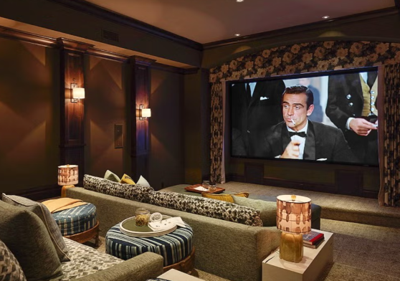
Designing a home theater that truly elevates your viewing experience takes thoughtful planning and an eye for detail—from acoustics and lighting to the right seating arrangement. Each decision can greatly impact your overall comfort and immersion, which is why it’s always helpful to revisit expert recommendations and trusted resources before you begin. For those seeking professional assistance, working with home theater installation companies can ensure your setup is precisely tailored to your space and needs.
Whether upgrading an entertainment room or building a dedicated space from scratch, the essentials remain the same: careful location selection, optimizing for sound and visuals, smart storage, and ensuring comfort for everyone. An expertly designed home theater can rival commercial cinemas by marrying technology with convenience and aesthetics.
Choosing the Right Location
The best home theaters start with the right space. A secluded room—ideally away from the main traffic areas of the home—helps reduce noise disruptions and keeps distractions at bay. Basements are popular because their underground position naturally blocks external noise and minimizes sunlight intrusion, allowing for better control over sound and visuals. Always measure your room to comfortably fit your desired seating and screen size.
Optimizing Room Acoustics
Great audio is a hallmark of the cinematic experience. Rooms with hard surfaces—bare walls, hardwood floors, or large windows—reflect sound, creating echoes and muddled dialogue. Add acoustic panels to your walls to improve clarity, and use thick carpets or area rugs to absorb excess noise. Hanging heavy drapes over windows will further muffle external sounds and stop echoes. Even minor changes, such as placing a bookcase or upholstered furniture in the room, can positively influence acoustics.
Selecting the Appropriate Screen Size
One of the most common mistakes in home theater setups is choosing the wrong screen size. A screen that’s too large makes it difficult for your eyes to process all the action, while a screen that’s too small can feel underwhelming. A reliable guideline is to divide the seating distance (in inches) by a number between 1.5 and 2.5 to get a recommended screen size. For instance, if your seating is 10 feet from the screen, an optimal screen would be between 48 and 80 inches. Match your screen’s resolution with its size and your viewing distance to achieve the sharpest picture quality.
Calibrating Your Display
Even the latest TVs and projectors need calibration to display images as intended. Unadjusted factory settings can result in distorted colors, unnatural contrast, or hotspots in dark scenes. Regular calibration—whether performed with a calibration disc or by hiring a professional—fine-tunes brightness, contrast, color temperature, and black levels for every environment. Investing time in these adjustments goes a long way to ensuring consistently stunning visuals every time you watch.
Investing in Quality Audio Equipment
Sound is just as crucial as picture in creating a theater-quality atmosphere at home. A surround sound system is ideal: standard 5.1 setups use five speakers and a subwoofer, while 7.1 adds two additional rear speakers for a more expansive soundscape. Ensure your AV receiver has adequate power and supports current audio standards (such as Dolby Atmos) for truly immersive sound. Upgrading your amplifier and speaker quality can transform everything from movie blockbusters to your favorite streaming series.
Strategic Speaker Placement
The arrangement of your speakers determines how sound moves through your room. Place the front left and right speakers at ear level, forming an equilateral triangle with the main seating position. The center channel—responsible for movie dialogue—should be directly above or below your screen. Surround sound speakers should be slightly above ear level and positioned to the sides or behind your viewers. The subwoofer performs best close to a wall but out of corners to prevent excessive bass buildup.
Controlling Ambient Lighting
Good lighting control is vital for getting vibrant color and deep contrast from your display. Natural light can wash out even the brightest screens, so use blackout shades or curtains to keep rooms dark during viewing. Dimmable LED lights let you find the perfect illumination level, and bias lighting (soft lights behind the screen) reduces eye fatigue and boosts perceived contrast. Control all lights from a single smart system for convenience.
Comfortable Seating Arrangements
Long movie nights require supportive and inviting seating. Arrange your chairs or sofas so each spot provides a clear screen view and the best sound. If possible, add a second tier of seating or use risers so everyone has an unobstructed view. Choose recliners or plush chairs for ultimate comfort, and pay attention to aisle space for easy movement.
Effective Cable Management
Wires and cords can quickly overwhelm even the most elegant home theater. Use cable trays, raceways, or in-wall conduits to conceal and organize cords. Color-code or label connections for easy troubleshooting, and consider wireless speakers or streaming devices to minimize clutter. A tidier setup not only looks great but also enhances safety and accessibility.
Incorporating Smart Home Integration
Smart home systems add unmatched convenience to a home theater. Universal remotes, mobile apps, or voice assistants can control everything from AV equipment and lighting to climate and shade systems, all from a single interface. Integrating smart technology helps streamline your entertainment experience, putting full control at your fingertips for an effortless transition between movies, games, and music.


(0) comments
We welcome your comments
Log In
Post a comment as Guest
Keep it Clean. Please avoid obscene, vulgar, lewd, racist or sexually-oriented language.
PLEASE TURN OFF YOUR CAPS LOCK.
Don't Threaten. Threats of harming another person will not be tolerated.
Be Truthful. Don't knowingly lie about anyone or anything.
Be Nice. No racism, sexism or any sort of -ism that is degrading to another person.
Be Proactive. Use the 'Report' link on each comment to let us know of abusive posts.
Share with Us. We'd love to hear eyewitness accounts, the history behind an article.